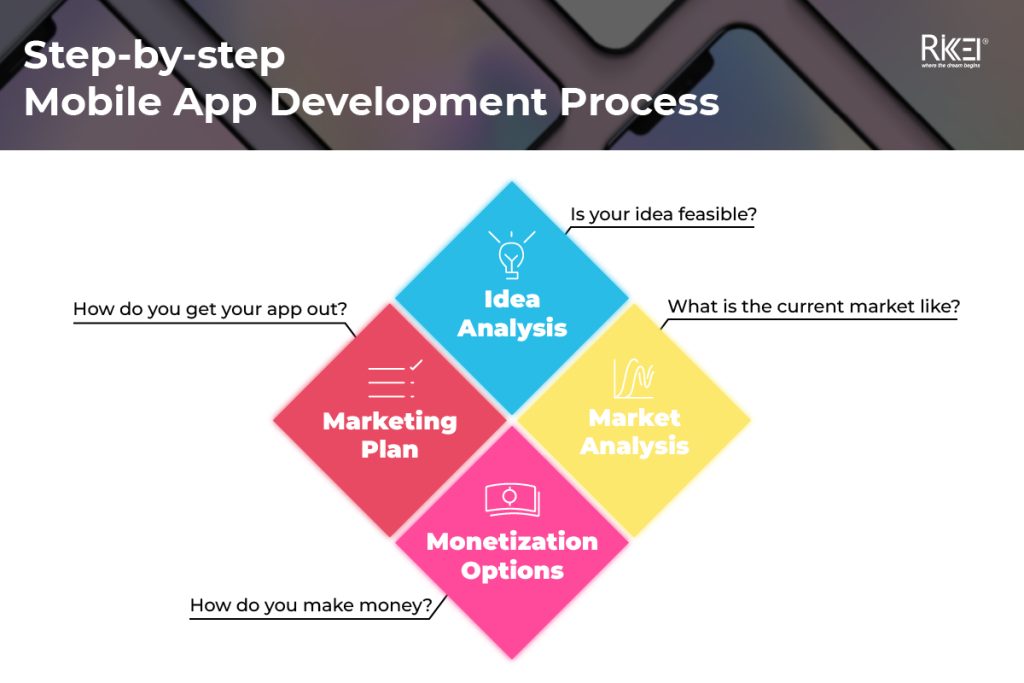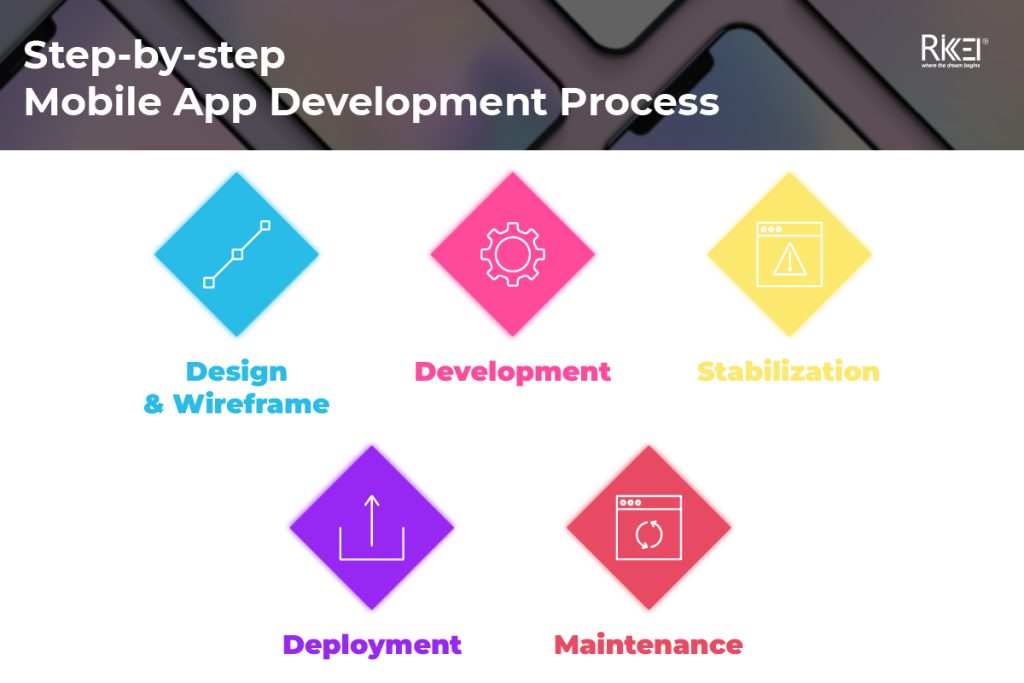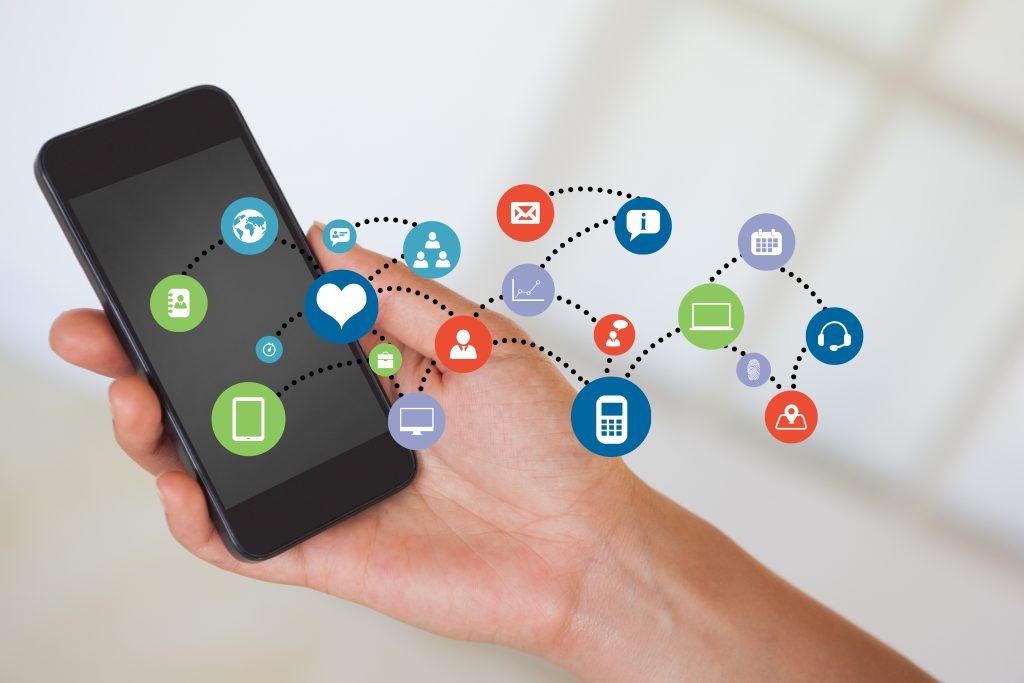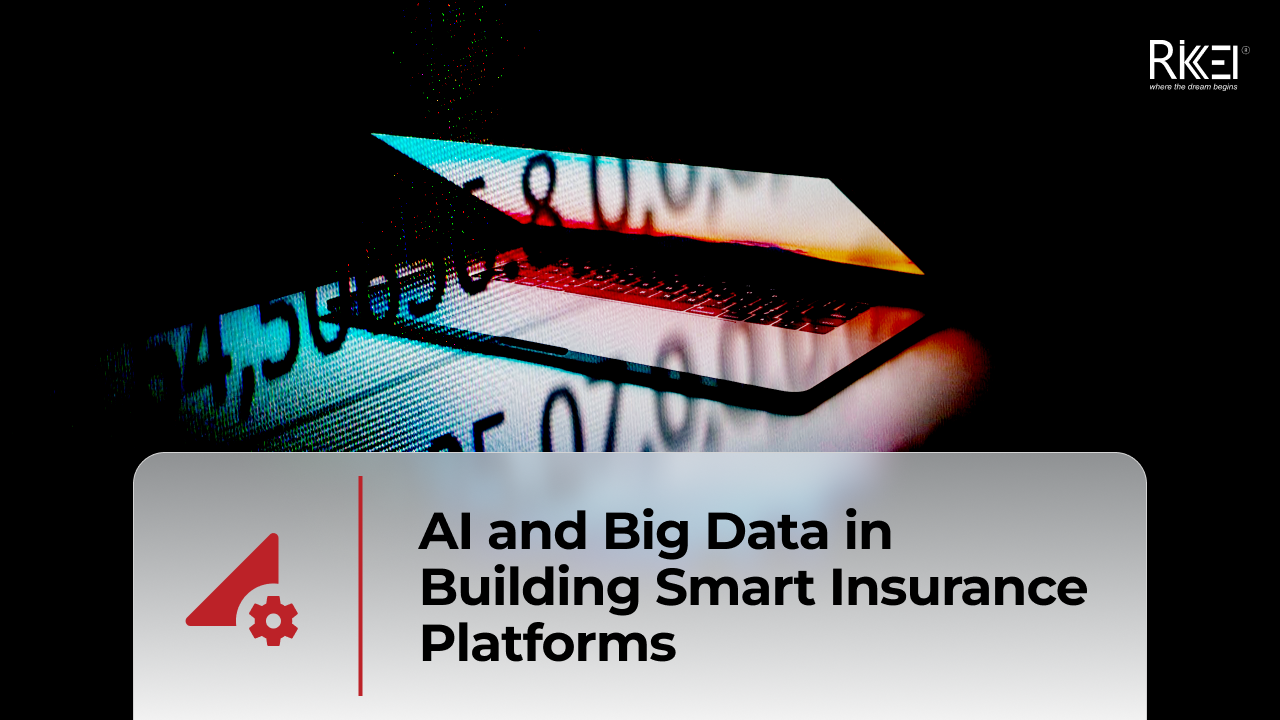Mobile App Development Process: 9 Important Stages (Infographic)
Contents
Smartphones have been slowly taking root in our society since the original iPhone’s introduction in 2008, and for good reasons. They are powerful, convenient, and a complete upgrade over past feature phones. In fact, an astounding number of over 6.2 billion people worldwide owns a smartphone in 2021, and that number is not slowing down any time soon.
How does this matter to you, a business owner? All of your employees and customers likely all own smartphones, and you can make their lives (and yours!) easier by implementing a mobile app into your company’s workflow. It can be an internal app for your employees or a gateway for your customers to interact with your business.
Thus, knowing the mobile app development process will benefit you when considering how to integrate apps into your workspace.
The Mobile App Life Cycle
Every app has a life cycle to itself. A life cycle might sound foreign to people without knowledge of mobile app development, but it is simply the process of making an app and nurturing it. The life cycle of the average mobile app consists of six stages, each requiring as much attention as another.
| Mobile app life cycle stage | Definition |
| Planning | Define your mobile application idea – your requirements, the app’s purpose, how you are getting the app done, benefits the app can give you and your business. |
| Design & Wireframe | Come up with two main pillars of an app – User Interface and Functionality.The User Interface is the face of the app that users interact with the most.Functionality is how the app works and what it allows users to do within. This is done by building a wireframe for a rough idea of how the system works. |
| Development | The actual code-writing part of the cycle. This stage is often done in two parts: prototyping and building.Prototyping: almost like a sketch, prototype models are used to quickly test ideas before building the appBuilding: the most time-consuming part of the life cycle. The previous stages serve as guidelines for the most suitable end result. |
| Stabilization | Testing and assuring the mobile app’s quality, ensuring that nothing “breaks” or doesn’t work as intended. |
| Deployment | The launch of the app, often done through an app marketplace like iTunes or Google Play. |
| Maintenance | Post-release support of the application. You can add new features or fix hidden errors after your app launches to make the lifecycle whole. |
Preparations for Mobile App Development
Let’s explore how to start mobile app development with some preparations. The preparations for the mobile app development process lie within the Planning stage of the app’s lifecycle. Here, you have to thoroughly define the boundaries of your app and everything around it through four primary factors of the app’s success:

Step 1: Idea Analysis
By analyzing your idea, you can straighten out many of the kinks you might not have paid enough attention to during initial ideation. Here, it would be best if you took notes of what your app wants to achieve, its targeted audience, your company’s development resource, your requirements for the app, and risks your company might face during development.
Step 2: Market Analysis
Where are you placing your app on the market? The answer to that helps you take a more clarified view of the current market and decide who your chief competitors will be. With this information, you can further study your competition’s strategies and mistakes to minimize the risks of mobile app development.
Step 3: Monetization Options
Your mobile app should be able to generate profits unless made for internal use. Otherwise, you ought to think about how to make money from the app, which is in this case choosing a monetization model you could use. The most common models for mobile apps are:
- Single purchase: Upfront purchase to use, no additional costs
- Freemium: Free to download with additional purchases for extra features
- Subscription: Periodically charges for ownership
- Portal: Free to download as a gateway to services.
Step 4: Marketing Plan
Unless your app is for internal use, a marketing plan for your mobile app is necessary so that the app can reach as many people as possible. Your marketing team’s job is to figure out how to promote your mobile app and acquire new users. Work closely with them to ensure their goals align with your vision for mobile app development.
Step-by-step Mobile App Development Process

Step 5: Design & Wireframe
The first step after planning in the mobile app development process is Wireframing and Designing your app. As previously mentioned, this step aims to figure out the two main factors of the mobile app: its User Interface and its Functionality.
- The user interface (UI) is the customer’s primary contact point with the application, so your attention should be diverted here first. It is required that the user’s experience with the UI be as frictionless as possible. A clean and smooth interface eases the pain of learning a new app for your users, possibly converting them into customers faster as well.
- You should decide on the screen frame size of the app at this stage, then make sure that your visual elements scale well for every screen size.
- The functionalities of the mobile app are visualized through wireframing the primary idea. By utilizing a wireframe, developers understand the system’s flows and more intricate features, while UI designers get further assistance in crafting the best interfaces for users. When designing the wireframe, you should consider using familiar patterns that your users might have picked up from other apps to reduce the time users need to learn your mobile app to a greater extent.
Step 6: Development
The meat of the project, the actual mobile app development stage, is split into smaller steps in which you can fine-tune your desired mobile app project. It is highly recommended that you consult with your mobile app developers to better understand what is best for your app at this stage. Changes are hard to implement once the project has reached a certain point in development. Outlined here are stages that are generally taken during this phase of mobile app development.
- Platform decision: The earliest decision to be made in the mobile app development process. Typically, mobile apps are built with one of the three categories of development platforms:
| Native | Mobile apps developed for a specific platform (Android or iOS). These apps are fully compatible with their ecosystems, and the development is supported by languages and tools made for their chosen medium. |
| Cross-platform/Hybrid: | These apps are written for multiple platforms from the start and are often written in HTML5 for maximum compatibility within parameters. |
| HTML5 Web: | These “apps” are actually optimized websites acting like an app. Due to its detached nature, it is not dependent on the users’ platform but has the worst user experiences compared to the previous two development platforms. Usually, apps only resort to this method if they are confident they will not be going on a marketplace, and/or users are not expected to download the app. |
Knowing which development platform to choose for your requirements early reduces any headaches you might have later during the mobile app development process. Switching platforms and codebases is expensive both in cost and time for the developers involved.
- Development: The actual development of the mobile app requires developers to work on three separate but equally essential components of the app in order to launch the final product: the frontend, backend, and the application programming interface (API).
| Frontend Development | Also called “client-side” programming. The frontend is the face of your app and what your users interact with each time they use it. This includes the mobile app’s structure, design, animations, and any behavior your users can see on screen. |
| Backend Development | Also called “server-side” programming. The backend supports the frontend by establishing database and server connections so that functionalities of the frontend stay responsive and operative. |
| API | Protocols, practices, and tools specifying how components of the software interact. Properly developed APIs allow for seamless integration between different apps, services, and devices. |
Step 7: Stabilization
Testing. That is all there is to this step. Exhaustively testing your mobile app for bugs and unintended interactions before releasing ensures a good user experience and more time to focus on those rare errors that might have slipped past your testers. The mobile app in development should be put through two rounds of tests: functional and non-functional
- Functional tests see if your mobile app is up to your functional requirements and specifications standards. Make sure that it accepts the right input while producing the correct output.
- These tests are done chiefly manually, with a minimal amount of automation involved. By the end of this process, your mobile app should work just as you intended it to.
- Non-functional tests evaluate everything that is not directly related to the mobile app’s functionalities. This includes, but is not limited to, performance, usability, compatibility, security, and certifications.
- Non-functional tests, unlike functional ones, are very hard to do manually, hence the significant usage of automatic tools for this testing round.
Like all phases in software development, you can outsource your testing to a third party vendor to have your mobile app be thoroughly tested by teams with industry-standard equipments and procedures.
Step 8: Deployment
Congratulations, you are now ready to publish your mobile application! Or you might have second thoughts about it, which is why a prior beta release is helpful. By releasing a beta version of your mobile app, you can gather real usage data and feedback about the app while not having to worry about any problems going out of control with the limited user base.
After the limited beta release and any fix you might have to do to your app, it is time to take it on current storefronts. Prepare your information for the marketplace providers so that the deployment of your app goes without a hitch.
Step 9: Maintenance
It does not stop at the launch of your app. After release, you might want to listen to customer feedback to identify current pain points of the mobile app and set out to fix them. Maybe it was a bug that slipped through, a quality-of-life update, or even new features you have never thought of but your users would love to have in the app. Either way, you have to be ready to roll out updates for your mobile app as needed to show users that you care about your mobile app
Mobile App Development Process FAQ

- How long does it take?
Mobile App Development can be done in less than a day for “for-fun” projects and applications. Still, for anything more polished and worthy of being used for a business, the expected timeframe is about 8-10 weeks for simple apps and up to 9 months for the most complex of them.
- How many people are needed for Mobile App Development?
To assure quality, a team of Mobile App Developers should have a minimum of 4-10 people. However, building a team of that many experienced developers might be difficult and expensive, so you can outsource your mobile app development needs to a trusted external IT vendor like Rikkeisoft.
- How much does it cost for Mobile App Development?
The honest answer is: we cannot tell. Mobile app development costs vary wildly between projects and are based on many factors like app complexity, development duration, and how many people helped make it. An app can cost anywhere from $40000 to upwards of $100000 in the United States, for example.
- Which is the most important stage in Mobile App Development?
There is no “most” important stage in mobile app development since they all carry the same weight towards creating a flawless experience for your users.
- How to reduce the cost of Mobile App Development?
To reduce the (somewhat) high cost of developing a mobile application, you can look into outsourcing your app project offshore. At Rikkeisoft, we offer a multitude of services regarding software development, including Mobile App Development suited to your every need.
Closing Thoughts
A mobile app might be what it takes to bring your business to the next level. However, it is also very time-intensive and costly if you do not come well-prepared. Therefore, you should thoroughly evaluate to see if the mobile application will benefit your business enough to go through with the entire mobile app development process. Should you decide to push the idea forward, Rikkeisoft is happy to assist your business with turning your dream mobile application into reality.
More From Blog

October 28, 2025
Australia’s Fintech Revolution: Trends Shaping the Future of Digital Finance
Australia has emerged as one of the most dynamic fintech hubs in the Asia-Pacific region, driven by strong consumer demand for digital financial services, supportive government regulations, and the widespread adoption of innovative technologies. As the industry matures, the imperative for digital transformation has become unmistakable: fintechs and financial institutions alike are under pressure to […]

August 12, 2025
AI and Big Data in Building Smart Insurance Platforms
The insurance industry is now standing at a pivotal moment in its digital evolution. Traditional insurance models built on historical data analysis and reactive risk assessment are rapidly giving way to intelligent, predictive platforms powered by artificial intelligence and big data analytics. This transformation represents more than technological modernization; it’s a fundamental reimagining of how […]

July 23, 2025
Insurtech’s Game-Changing Trends: How AI and Digital Transformation Are Reshaping Insurance
The financial technology sector is experiencing unprecedented change, making it essential for business leaders and technology professionals to stay ahead of emerging innovations. Throughout 2025, insurance technology (insurtech) has emerged as a powerful catalyst for change, fundamentally altering how insurance providers conduct business, engage with clients, and assess risks. This technological evolution represents more than […]

April 4, 2024
Big Data Performance: Maximize Your Business Value
In today’s data-driven world, organizations are constantly generating and collecting immense amounts of data to understand their customers more deeply. This data, often referred to as “big data,” holds immense potential for organizations to seek opportunities and overcome challenges. But accessing and analyzing big data isn’t enough to have proper strategies; organizations must pay attention to […]

April 4, 2024
How Real-Time Data Analysis Empowers Your Business
In today’s fast-paced business landscape, the ability to quickly make data-driven decisions has become a key differentiator for success. Real-time data analysis, the process of analyzing data as soon as it’s generated, has emerged as a powerful tool to empower business across industries. By leveraging real-time data analysis, organizations can gain timely and actionable insights, […]

April 4, 2024
Differences Between Data Science and Computer Science
Data Science and Computer Science are distinct fields overlapping in certain areas but have different focuses and objectives. The article below will help you clearly understand the differences and the close connection between the two fields. What is Data Science? Data Science is an interdisciplinary field that combines scientific methods, processes, algorithms, and systems to […]

